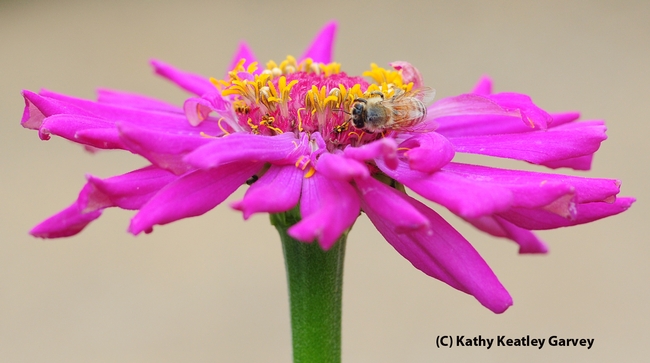Eye-catching zinnias grace the Häagen-Dazs Honey Bee Haven, the half-acre bee friendly garden planted in the fall of 2009 next to the Harry H. Laidlaw Jr. Honey Bee Research Facility on Bee Biology Road, University of California, Davis.
The long-stemmed vibrant flowers attract honey bees from the Laidlaw apiary, neighboring bees, and assorted other pollinators, including sunflower bees (after all, zinnias belong to the sunflower family, Asteracae).
Last year the haven attracted the attention of Australian author Mark Leech, who was researching a book, Planting for Pollen and Nectar Supply for the Australian Rural Industries R&D Corp.
Leech, who lives in Lanceston, Tasmania, Australia, so far holds the record of traveling the greatest distance to visit the garden. The previous record-holder: beekeepers from Kentucky.
"The book," Leech wrote, "is to encourage planting for bee forage across the landscape from urban to the rural environment and all climate zones."
If you want to tour the garden, it's open from dawn to dusk--no admission. The key goals of the garden, the jewel of the UC Davis Department of Entomology and the California Center for Urban Horticulture, are to provide bees with a year-around food source for the Laidlaw bees and other pollinators; to raise public awareness about the plight of honey bees; to encourage visitors to plant bee-friendly gardens of their own; and to provide research opportunities.
Volunteer gardeners meticulously tend the garden every Friday morning. Sometimes you'll see them planting and watering on the weekends.
The art work in the haven is magnificent. Donna Billick of Davis, a self-described rock artist, created the 6-foot long ceramic sculpture of a worker bee. She and entomologist/artist Diane Ullman co-founded the UC Davis Art/Science Fusion Program, and spearheaded the art projects in the garden. The art itself is a magnet.
Native pollinator specialist Robbin Thorp, emeritus professor of entomology at UC Davis, monitors the garden for bees. To date, he's logged 70 different species of bees.
And some of them he found on zinnias.
Attached Images:


